Your teenager gets top marks in school, captains the debate team and volunteers at a homeless shelter. But then they text-message their friend while driving and rear-end another vehicle.
Neuroscientists used to think that the teenage brain was defective or “half-baked”. But groundbreaking research over the past 10 years has shown that this is not true.
Understanding Your Teen’s Brain
A teenager’s body goes through dramatic physical changes during adolescence that are easy to see. Less well known are the vital changes occurring in their brains. Adolescent brains are uniquely shaped and can be transformed by learning. But this special changeability is a double edged sword that both allows teens to make enormous strides in thinking and socialization while leaving them vulnerable to dangerous behaviors and serious mental disorders.
During adolescence, the networks that link brain regions are changing more quickly than at any other time in life. This rewiring is especially important in the areas that regulate emotions and control impulses. MRI studies show that the amygdala, which drives emotions and reactions, intensifies during puberty, while the prefrontal cortex, which controls reasoning and judgment, is not as mature until a person’s 20s. This mismatch can lead to a tendency to take risks and make decisions without fully considering the consequences.
Understanding this unique teen brain can help parents, teachers and counselors learn how to distinguish normal, age-appropriate behavior from that which might indicate illness or mental disorder. For example, a 16-year-old girl’s departure from her parent’s tastes in music or politics may be an indication of a developing sense of independence rather than mental illness. And, a boy’s willingness to climb on a skateboard and take risky dares from friends is more likely due to immature, short-range thinking than a desire to hurt himself.
Understanding Your Teen’s Emotions
At times your teenager will think and behave in irrational or impulsive ways. It’s important to remember that they have brains that are still under construction and that this can explain why their emotions sometimes get out of control.
For example, a teenage girl’s repulsion to her parents’ tastes in clothes or music is probably just part of normal development, and not a sign of mental illness. Similarly, a 16-year-old boy’s tendency to skateboard without a helmet or to accept risky dares from friends might be more evidence of short-range thinking and peer pressure than a desire to hurt himself.
Teenagers also tend to be deeply upset by well-publicised natural disasters or human tragedies such as wars or terrorist attacks. It is important for parents to help their children understand that these events are not their fault and that for every terrible act, many more people are trying to make things better.
Researchers are learning more about the way that teens process emotions. They are finding that teenagers use their amygdala more than their prefrontal cortex when making decisions and solving problems. It’s likely that this mismatch between brain maturation and social and emotional experience can lead to the kind of impulsive behaviour often seen in young people, including drug use, violence and self-harm. Understanding this can help parents decide whether to encourage or discourage their teen’s explorations of the world and how best to help them manage their emotions.
Understanding Your Teen’s Decisions
Many parents struggle to understand why their teenagers behave in a risky, irrational or dangerous way. It may seem that their behaviour is irresponsible or even reckless, but these impulsive actions might reflect normal brain development and are not an indication of mental illness.
Research has shown that during adolescence, there is a mismatch between the limbic system which drives emotions and the prefrontal cortex which controls impulses. This is why teens are prone to making poor decisions and can become overwhelmed by their emotions and temptations. It is also why they may struggle to see the consequences of their actions and often blame others for their bad decisions.
In addition, adolescence is an emotional time of testing limits and discovering one’s identity in the world. For example, teenage girls might experiment with drugs and alcohol, or they may engage in a first sexual relationship. Teens must also cope with the stress of school, peer pressures and social media.
When a teen approaches you with a problem, encourage them to think about solutions. Then help them identify the pros and cons of each option. This will make neural connections in the prefrontal cortex, which will strengthen their logical thinking skills for the future. It will also help them develop a healthy mindset and learn that they are responsible for their own decisions.
Understanding Your Teen’s Relationships
Have you ever wondered why your teenager sometimes behaves illogically or recklessly? For many parents, the erratic or dangerous behaviour of their teen can be extremely confusing. But understanding the teen brain can help you understand why their behavior is often impulsive and emotionally driven.
Unlike adult brains, which can be relatively stable over time, the teen brain is in a constant state of change. Known as neuroplasticity, the ability of the brain to change in response to experience is one of the greatest gifts and challenges of adolescence. It allows them to make amazing strides in thinking and socialization, but it can also leave them vulnerable to dangerous risky behaviours and mental illnesses.
In particular, the hormone-fueled limbic system undergoes dramatic changes during adolescence. This area regulates emotions and feelings of reward and interacts with the prefrontal cortex, which is responsible for rational decision making and planning. During puberty, this system can become overwhelmed by the hormones that are released during this time and may lead to overreaction.
Moreover, as their prefrontal cortex develops, teens will likely find that they have less control over certain emotions such as fear and anger. This may explain why they are prone to be more easily swayed by the opinions of their peers and may be more inclined to take risks. In addition, researchers have found that when teens are rejected by their peers their brains show more activity in the subgenual cingulate cortex and anterior insula. This suggests that teens can be particularly sensitive to rejection, a characteristic that might contribute to the development of internalizing disorders like depression and anxiety.

